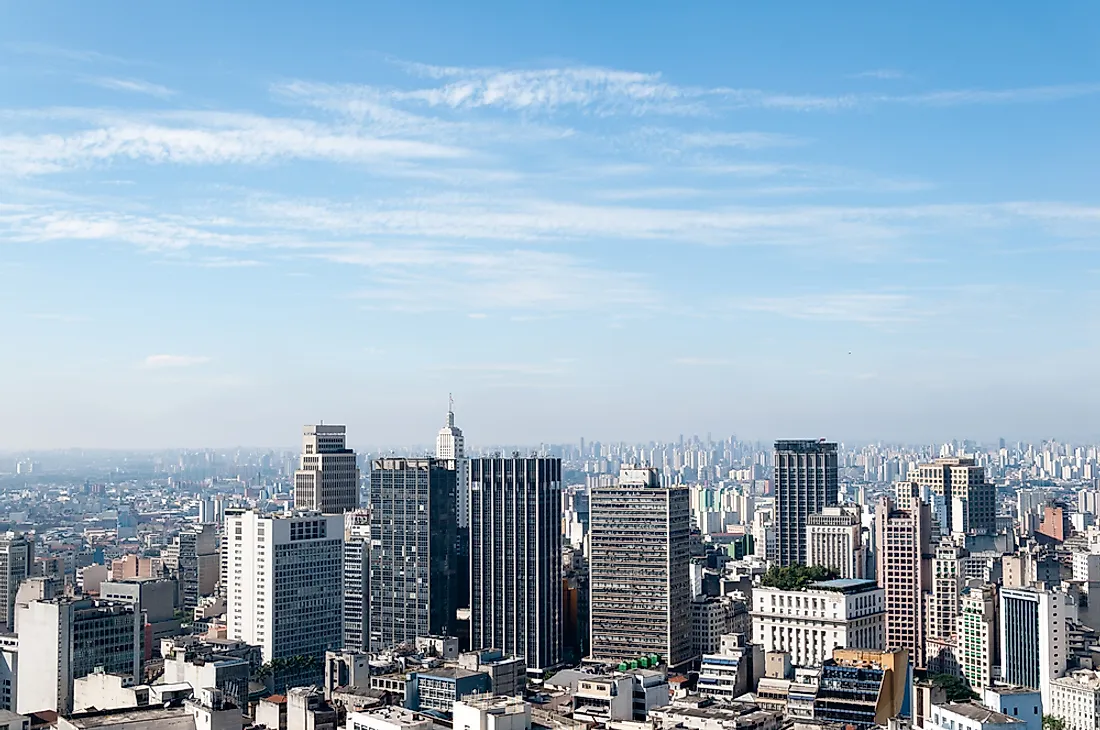Largest Cities In South America

South America has a population of approximately around 420 million people, making it the world's second least populated. The majority of the largest cities on the continent are found in Brazil, with entries also from Colombia, Peru, and Chile. The largest city in South America is Sao Paulo, Brazil, with a population of 21.7 million. All data from the United Nations' Population Division.
The Five Largest Cities in South America By Population
1. Sao Paolo - 21.7 Million
Sao Paolo is the largest city in Brazil as well as South America with a metropolitan population of around 21.7 million. It is the 12th largest city in the world by population. The proximity of the city to the Atlantic Ocean (only 70 kilometers away), makes it an ideal location as an international business center. Sao Paolo has the largest economy by Gross Domestic Product in South America, and the 10th largest GDP of any city in the world. The lucrative economic potential of the city has turned it into a truly cosmopolitan one, with large Japanese, Arabian, and Italian diasporas.
2. Buenos Aires - 15 Million
The Argentinian city of Buenos Aires is the second most populous city on the South American continent. As per UN estimates, more than 89% of Argentina’s population resides in urban areas, and one-third of the population dwells in and around Buenos Aires. The city, located in a strategic position on the western shore of the Rio de la Plata estuary, has easy access to the Atlantic Ocean. Of the nearly 15 million people living in Buenos Aires, many are immigrants who have moved into the country in a massive immigration wave from the European and Middle Eastern countries in search of a better life.
3. Rio de Janeiro - 13.4 Million
Rio de Janeiro is the third most populated city in South America and the second most populated city in Brazil. Like Sao Paolo, the nearness to the sea facilitated the rapid development of the city of Rio de Janeiro from an important Portuguese settlement in the 16th Century into a bustling modern metropolitan area of the current times. Rio de Janeiro is also home to the second largest GDP in Brazil, and is one of the most visited cities in the Southern Hemisphere. The beaches, landmark monuments, world heritage sites, carnivals, festivities, and overall happenings of life of Rio is responsible for attracting millions of tourists and immigrants from other countries to visit or stay in this truly multicultural city.
4. Bogota - 10.6 Million
Bogota, the capital of Colombia, is the fourth largest city in South America by population with a metro population of 10.6 million. Over recent years, Bogota has become more and more popular among tourists. Geographically, Bogota is centrally located in Colombia.
5. Lima - 12.1 Million
Lima, the capital of Peru, has a metro population of 10.4 million people. It is the fourth largest city in South America. As a capital city, Lima is the center for culture and financial activity in Peru. It is the largest city found in the northern portion of South America.
The Positives and Negatives of Large Population Numbers
South America is a very urbanized continent. The shifting of the population to urban areas has sped up the economic growth of the continent’s countries, and also reduced the cost of delivering basic services to the people as the populations are less dispersed. Today, the top 10 cities of the continent contribute nearly 30% to the continent's annual GDP. However, on the downside, many of the largest cities of South America face diseconomies of scale, and are struggling to overcome traffic problems, housing and water shortages, and other high population-related stresses.
Largest Cities In South America By Population
| Rank | City | Country | Population (Millions) |
|---|---|---|---|
| 1 | Sao Paulo | Brazil | 21.7 |
| 2 | Buenos Aires | Argentina | 15.0 |
| 3 | Rio de Janeiro | Brazil | 13.4 |
| 4 | Bogota | Colombia | 10.6 |
| 5 | Lima | Peru | 10.4 |
| 6 | Santiago | Chile | 6.7 |
| 7 | Belo Horizonte | Brazil | 6.0 |
| 8 | Brasilia | Brazil | 4.5 |
| 9 | Fortaleza | Brzil | 4.0 |
| 10 | Recife | Brazil | 4.0 |











